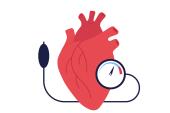CardioMEMS Beats Standard Care in First European RCT: MONITOR-HF
The small, investigator-initiated trial of PAP monitoring to guide care in chronic HF should inspire uptake in Europe, the PI says.

PRAGUE, Czechia—Using a pulmonary artery pressure (PAP) monitor on top of best medical care results in significant improvements in quality of life and “substantial” reductions in heart failure (HF) hospitalizations among patients with chronic HF, according to the results of the MONITOR-HF trial.
Though small, the trial is the first randomized, controlled trial of PAP monitoring outside of the US and as such, has implications for countries across Europe, said Jasper Brugts, MD, PhD (Erasmus Medical Center, Rotterdam, the Netherlands), who presented the results this weekend during a late-breaking clinical trials session at the European Society of Cardiology Heart Failure (ESC-HF) 2023 Congress.
“PA-guided therapy resulted in a significant improvement in quality of life and a substantial reduction in total HF hospitalizations, and we observed consistent effects on multiple levels: a large impact on mean PAP, a large impact on NT-proBNP, and also, primarily, changes in diuretics,” said Brugts, noting that the device was also safe and reliable. “This is a novel trial in a different healthcare system, [so] these data are relevant for uptake of this new technology in Europe.”
The CardioMEMS system (Abbott) was first cleared by the US Food and Drug Administration in 2014 based on the CHAMPION trial in patients with NYHA class III HF. The US indication was later extended to patients with NYHA class II HF or elevated natriuretic peptides, based on GUIDE-HF. In Europe, the 2021 HF guidelines gave invasive PAP monitoring a IIb recommendation in symptomatic HF patients with LVEF < 35%. While registry studies have suggested that despite different health delivery and reimbursement models the device would likely perform in a similar fashion in European countries as in the US, this hadn’t previously been addressed with randomized trial results, said Brugts.
MONITOR-HF
MONITOR-HF was an investigator-initiated study funded by the Dutch Ministry of Health and Health Care Institute. Brugts and colleagues enrolled 348 chronic HF patients with NYHA class III symptoms and at least one heart failure hospitalization in the last year. Patients were randomized to standard medical care alone or to the PAP-guided therapy with the CardioMEMs system and followed for 12 months.
Most patients in both arms (> 95%) were taking a loop diuretic, over 85% were taking a renin-angiotensin-aldosterone system (RAAS) inhibitor, and roughly the same proportion were taking beta-blockers and mineralocorticoid receptor antagonists (MRAs). Just 6.8% of patients in the monitoring group were taking a sodium-glucose cotransporter 2 (SGLT2) inhibitor as compared with 12.2% in the standard care group. Over half of patients had an implantable cardioverter-defibrillator (ICD) at baseline and more than 25% had a cardiac resynchronization therapy (CRT) device.
At 12 months, quality of life according to change in Kansas City Cardiomyopathy Questionnaire Overall Summary Score (KCCQ-OS), the study’s primary endpoint, was up more than 7 points in the PAP arm, while scores actually declined slightly in the standard-care patients, for a between-group difference of 7.13 (95% CI 1.15-12.8).
Over a median follow-up of 1.8 years, HF hospitalizations and urgent care visits were nearly halved among the monitored patients, reaching 212 in the standard-care group at 48 months as compared with 117 in the PAP-monitored patients (HR 0.56; 95% CI 0.38-0.84).
In an intention-to-treat analysis, a range of cardiovascular endpoints including total HF hospitalizations, total HF hospitalizations/deaths, time to first HF hospitalization or urgent visit, and a composite of time to first HF hospitalization, urgent visit, or death all favored the monitoring approach. Differences in CV and all-cause mortality also went in the direction of monitoring, but the trial was not powered to show a difference.
A subgroup analysis focused on total HF hospitalizations found no relevant heterogeneity above or below the ejection fraction cutoff of 40%. Median NT-proBNP as well as mean PAP also declined over the course of the 12 months of study. The PAP improvement, Brugts noted, was “quite significant and larger than that observed in the two US trials.”
Importantly, he continued, additional analyses suggested that the effect of PAP monitoring appeared to be driven largely by changes in diuretics—both cumulative numbers of changes in diuretics, as well as “fine-tuning” doses (both up and down) were more common in the PAP-monitored patients.
And while both groups had high uptake of guideline-directed medical therapy (GDMT) over the course of the trial, with angiotensin receptor-neprilysin inhibitor use increasing to 56% and SGLT2 inhibitors increasing to 31% overall, cumulative changes were greater in the PAP group. This too, suggests that additional medication adjustments likely helped to reduce HF hospitalizations in the monitored patients, Brugts said.
Safety and reliability were comparable to rates seen in CHAMPION and GUIDE-HF.
Fab Five?
“This is close to a standing ovation that you just got here,” Frank Ruschitzka, MD (University Heart Center, Zurich, Switzerland), one of the session moderators, observed after Brugts presentation.
Does MONITOR-HF make the case for diuretics to be “brought back into the ring” as guideline-directed medical therapy, Ruschitzka asked. “Not just the ‘fab four’ but the ‘fab five?’”
“I completely agree,” Brugts replied. “I think diuretics are the cornerstone of the effectiveness of this therapy . . .. This is what we were missing in our armamentarium, which is a good parameter to focus our diuretic therapy,” a gap PAP monitoring helps to fill.
The concordance between CHAMPION, GUIDE-HF, and MONITOR-HF is “remarkable,” said Brugts. The three trials “have been done in different eras, with evolving GDMT, with different conditions of the pandemic, but also different healthcare systems, and I think it is really supportive of PA monitoring in general.”
Implanting the monitor is “not without risk,” he added. “You should be careful and select the right patients, but this is ready for a higher uptake, but we must focus on which patient to select, and which patient is mostly like to benefit with this technology.”
Ruschitzka seemed to agree. “This is good news for us believers in hemodynamics. Get the water out as quickly as possible. That’s the take-home message.”
Shelley Wood was the Editor-in-Chief of TCTMD and the Editorial Director at the Cardiovascular Research Foundation (CRF) from October 2015…
Read Full BioSources
Brugts, JJ. Remote hemodynamic monitoring of pulmonary artery pressures in patients with chronic heart failure. Presented at ESC-HF 2023. May 20, 2023. Prague, Czechia.
Disclosures
- Brugts reports receiving speakers or advisory board payments from AstraZeneca, Abbott, Bayer, Boehringer-Ingelheim, Daiichi-Sankyo, Novartis, and Vitor, as well as research funding from Abbott, which also covered MONITOR-HF study costs.





Comments